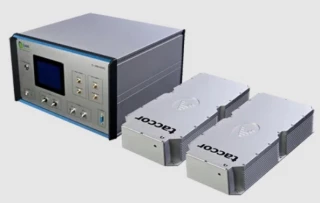Ultrafast Lasers
Frequently Asked Questions
What are ultrafast lasers?
Ultrafast lasers are lasers that produce extremely short pulses of light, typically on the order of picoseconds or femtoseconds. These lasers are used in a variety of applications, including material processing, biomedical research, and spectroscopy.
What is the advantage of using an ultrafast laser for material processing?
Ultrafast lasers can process materials with very high precision and minimal heat-affected zones, which can result in better surface quality and fewer defects. Additionally, the short pulse durations of ultrafast lasers can help to minimize thermal damage to the surrounding material.
What is the difference between a mode-locked laser and a Q-switched laser?
Both mode-locked and Q-switched lasers produce short pulses of light, but they use different mechanisms to achieve this. Mode-locked lasers use a device called a mode-locker to produce a train of very short pulses, while Q-switched lasers use a fast shutter or other mechanism to block the laser output until the desired pulse energy has built up.
What is the typical output power of an ultrafast laser?
The output power of ultrafast lasers can range from a few milliwatts to several watts, depending on the specific laser design and application. Higher output powers may be required for material processing applications, while lower powers are typically sufficient for spectroscopy or biomedical research.
Can ultrafast lasers be used for imaging?
Yes, ultrafast lasers can be used for a variety of imaging techniques, including multiphoton microscopy and optical coherence tomography. These techniques take advantage of the short pulse durations and high peak powers of ultrafast lasers to produce high-resolution images of biological tissues and other materials.
What are the applications of ultrafast lasers?
Ultrafast lasers have a wide range of applications in industries such as materials processing, biomedicine, and spectroscopy. They are used for precision cutting, drilling, and welding of materials, as well as for medical treatments such as LASIK eye surgery.
What is the limit on peak power for ultrafast lasers?
The limit on peak power for ultrafast lasers depends on the specific laser technology and the intended application. However, some ultrafast lasers are capable of producing peak powers in the range of gigawatts (10^9 watts).
What is the limit on energy for ultrafast lasers?
The limit on energy for ultrafast lasers also depends on the specific laser technology and the intended application. However, some ultrafast lasers are capable of producing pulse energies in the range of millijoules (10^-3 joules).
Discover the latest advancements in ultrafast laser technology with FindLight's collection of ultrafast lasers from leading manufacturers worldwide. Browse our extensive selection of lasers ranging from femtosecond lasers to picosecond lasers and discover the ideal laser for your research or industrial needs. Our ultrafast lasers are perfect for a variety of applications, including microscopy, material processing, and medical research. With detailed specifications and product comparisons, FindLight makes it easy to find the right ultrafast laser for your specific needs.







